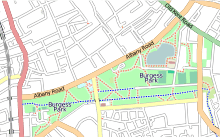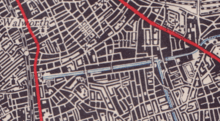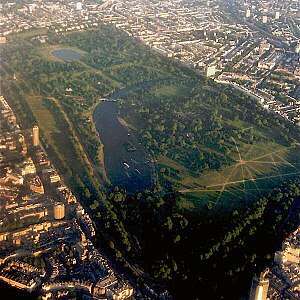Burgess Park
Burgess Park is a public park situated in the London Borough of Southwark, in an area between Camberwell to the west, Walworth to the north, Bermondsey to the east and Peckham to the south. At 56 hectares (140 acres), it is one of the largest parks in South London.[1]
.jpg)
Unlike most other parks in London, Burgess Park was carved out of a highly built-up area of the city. Virtually all the land now occupied by the park was previously used for housing, industry and transport infrastructure.
Construction


The idea for Burgess Park came out of the 1943 Abercrombie plan for open spaces in London, and the land has been gradually assembled and landscaped over the subsequent decades, first by the London County Council, then the Greater London Council, and since the mid-1980s, the London Borough of Southwark.
An important stage in the construction of the park was the closure of the Grand Surrey Canal in the early 1970s, which terminated at Addington Wharf on Walworth Road. The Canal served the Surrey Commercial Docks, and the area near Camberwell was full of 19th-century streets, houses and industrial buildings (including a ginger beer factory), many of which had suffered heavy bomb damage during WWII. The stretch of canal now incorporated in the Park is the site of Camberwell Wharf, which was virtually straight. Other land incorporated in the park was occupied by housing. While some of this housing was in poor condition, a lot of perfectly serviceable homes were demolished to build the park, and this has resulted in strong local feelings about the park.

Named Burgess Park in 1973 (after Councillor Jessie Burgess, Camberwell's first female Mayor), it is still incomplete and contains some former roads which have been stopped up but not yet grassed over. The boundaries of Burgess Park remain a matter of dispute, and because the park is unfinished, it is regularly the subject of proposals to build housing, schools, or transport links of the sort that would never be contemplated in one of London's older parks of Victorian origin.
Features

There are listed buildings in the Park, remnants of the streets which once occupied the site: a lime kiln, the library, baths and wash houses and the former almshouses in Chumleigh Gardens. There are also several bridges, which once used to cross the canal.
Chumleigh Gardens, near the centre of the park, is a World Garden, with plants and landscaping designed to reflect the diversity of the surrounding population of this highly cosmopolitan portion of London.
There is a thriving Friends of Burgess Park who also have an online heritage project on the park, Bridge To Nowhere. In the past, the park has played host to many festivals, including, in August, the Carnaval Del Pueblo, Europe's largest celebration of Latin American culture.
In 2009, Burgess Park was one of 11 parks throughout Greater London chosen to receive money for redevelopment by a public vote. The park received a grant of £2 million from Boris Johnson, Mayor of London, as part of a London-wide competition, and the money was used to install better footpaths, additional lighting, refurbished public toilets and new play areas for children.[2] Subsequent plans existed to top this up to £6 million by Southwark Council, to ensure the renovation of the space.
References
- "Southwark Council Burgess Park". Southwark Council. 2013. Archived from the original on 29 August 2013. Retrieved 11 September 2013.
- "London parks get £6m for revamp". BBC News. 4 March 2009. Retrieved 10 March 2009.
External links
- Facilities in Burgess Park
- Friends of Burgess Park
- Burgess Park – landscape architecture
- Friends of Burgess Park/Bridge To Nowhere
